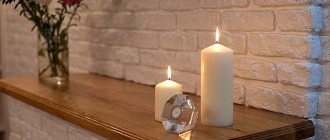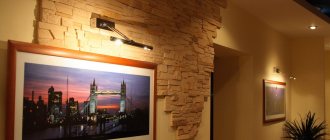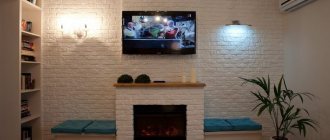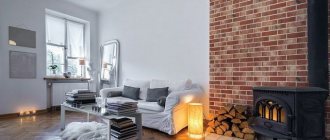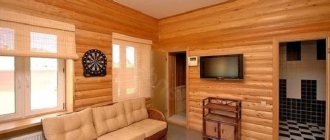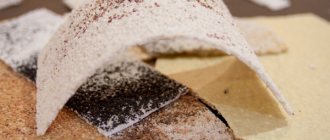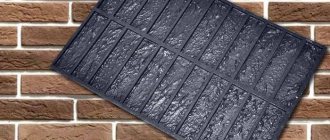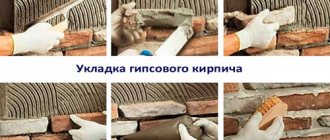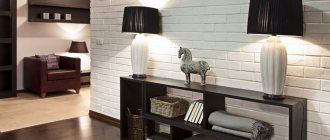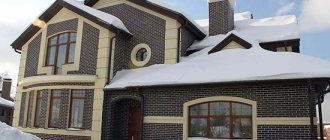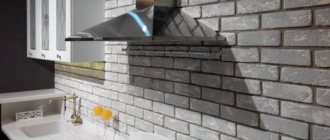SHARE ON SOCIAL NETWORKS
FacebookTwitterOkGoogle+PinterestVk
When choosing a material for decorating an apartment or country house, you should pay attention to decorative tiles imitating stone or brick. It can be used for uniform wall cladding or combined with wallpaper. Despite its apparent simplicity, brick-like tiles for interior decoration have a number of installation features that must be taken into account when planning to work with them.
Using brick-like tiles you can implement interesting design solutions for your home
Features of decorative material
One of the ways to make a building unique is to cover its facades with tiles. The rectangular, strict forms of this material create visual appeal against the backdrop of the urban ensemble. But decorative tiles are most suitable for indoor interior design.
It can be used as a solid canvas covering the wall, or as individual elements of a design ornament. Moreover, you can veneer not only the walls themselves, but also fireplaces, niches, shelves, door and window openings.
Homemade wall design options for brickwork
- Homemade gypsum brick is a beautiful, original material, easy to create.
- Ordinary polystyrene foam with melted edges and an uneven surface, attached to the wall and covered with a layer of paint will be a good imitation. Cheap, fast, beautiful.
- Plastering walls using a stencil - in this case, the surface will be too neat, but if you like an unobtrusive pattern on a plain wall, this is your option.
- The second option is to apply a design using masking tape onto the wet plaster, press it a little and remove it - a relief will appear.
See also: Artificial stone in the interior of the hallway
A sofa against a brick wall will look practical
In large rooms, the walls can be decorated with decorative bricks
The walls in the corridor can be decorated with decorative bricks
See alsoLarge clock in the interior: photos, views
Advantages of brick cladding
- ease of installation, which is ensured by the ability to easily file a fragment and adjust its dimensions to the desired location on the surface;
- due to the ease of processing individual rectangles, external and internal corners acquire an attractive appearance;
- the ability to separate different zones in an apartment or room, emphasizing their aesthetic appeal;
- allows you to eliminate internal surface defects in the room, for example, you can easily remove unevenness and other imperfections on the walls;
- the ability to choose the color and texture to suit every taste, place an order for production according to the sample you like;
- strength and durability in use;
- ease of care and the ability to be used in decorating various premises.
Installation of decorative bricks
Installation must be carried out by specialists, just like laying tiles; this activity requires practice. You can always try to do the repairs yourself - just like wallpapering, laying decorative bricks with due diligence can become a reality even for a beginner. For installation, you need to purchase all the necessary materials, dilute the cement mortar, apply it to the wall with a spatula and begin installation. If you plan not to make gaps between the tiles, you should take into account that the rectangles of the tiles are not perfectly even and if you do not take care of this, the level may shift and the entire row will “float”.
See also Bottle decor for rooms in different styles
Ceramic tile
Many people unfairly accuse this type of solution of having little originality. But that's not true. Clay is used for production. It is mixed with quartz sand, as well as various carbonates and dyes. Products can be given a wide variety of surfaces and colors that are most suitable for a specific interior can be selected.
For interior decoration, you can purchase a “brick-like” material that has a smooth, glossy or rough surface, and also add an antique effect to the interior.
How clinker tiles are made
Created by mixing water and artisanal clays such as kaolinite and illite, rich in alumina and quartz, clinker is one of the strongest and most durable ceramic wall and floor coverings.
The mixture is first placed in mixing tanks and then shaped on drawing machines to produce 9 to 25 millimeter thick tiles or bricks in a variety of shapes.
The manufactured items are then sent to dryers to remove excess moisture that could degrade their quality. The final stage is firing, which lasts 34 hours in tunnel or roller kilns at a temperature of 1250 degrees, so that the material reaches a constant density.
Advantages of ceramic material
- lightness in weight;
- increased strength and durability;
- low water absorption rates;
- excellent frost resistance and resistance to fading under the influence of sunlight and aggressive environments;
- safety for humans.
Ceramics are used in the kitchen, in hallways, and in places where brick imitation is required, since using real brick would be irrational. For example, for decorating loggias, balconies, fireplaces or arches.
Types and processing of clinker tiles
When choosing clinker tiles, you can choose different shapes and colors to suit your taste.
Clinker tiles are:
- Square;
- Rectangular;
- Octagonal;
- Strip;
- A variation of the classic brick.
The surface can be glazed, i.e. covered with a glassy layer of glaze, which gives the tile greater impermeability, or unglazed, that is, without coating.
As for colors, many shades, both light and dark, can be obtained based on the glazes used, while the color of natural clinker depends on the dosage and quality of the clay and ranges from sandy yellow to orange and brick red. to dark brick.
In any case, unglazed tiles can be body-painted, i.e. the glaze is added during one phase of cooking and colors both the base and the exterior, instead in the case of glazed tiles the color is fixed in the second phase of cooking and is present only as a coating.
Finishes also vary, depending on the desired effect; First of all, you can choose between a glossy or matte glaze, and there are various other processes that can be done to clinker tiles, including:
sanding: carried out using machines equipped with rotating discs and serves to remove all surface defects and roughness to obtain a completely smooth floor, especially suitable as a background for modern furniture;
Firing: a treatment that is performed by placing the tile in contact with a high temperature flame to produce darkened areas with reduced chromaticity;
Sandblasting: This involves blasting highly abrasive grains of sand and glass onto the floor using high pressure equipment to create a rough and matte surface. This type of treatment is widely used for outdoor work, as it gives floor coverings excellent anti-slip properties.
There is a special variety known as porcelain clinker. Ground porcelain is added to the ceramic mixture, which increases the strength and durability characteristics.
Clinker finishing
The high strength of the material made from refractory clay, combined with increased lightness, allows it to be used for cladding facades and foundations.
Clinker tiles are very elastic and resistant to external aggressive environments. It will help you give the facade an original look, significantly saving on costs.
But even indoors, such decoration will look very original. You can easily verify this by looking at various photos of such brick-like tiles.
It goes well with many interior design styles and can be used together with other types of finishing - plaster or wallpaper. For example, white products are widely used in the arrangement of premises where the loft, modern or country style was implemented.
Contrasting accessories
A number of simple design techniques will help to revive the monotonous surface of “brick” walls. For example, visual zoning of floors. One or more contrasting horizontal lines can easily be made from tiles of a different color.
Windows, doors and even the corners of the building will look brighter and more interesting if framed with special elements. They are also often chosen to contrast with the color of the walls - lighter or darker. But if you are a fan of classic combinations, then you can match these elements exactly to the tone of the HAUBERK façade tiles. The TECHNONICOL company offers metal protective and decorative external/internal corners (50 × 50 × 1250 mm) and platbands (50 × 100 × 1250 mm) coated with basalt granules. The decor of windows, doors, corners of the building will be even more expressive if it is complemented with edging made of tiles of the same shade.
The transition from the facade to the plinth is decorated with a special plinth strip (17 × 85 × 20 × 1250 mm). It gives it a finished look and protects the upper part of the base from precipitation.
Branded corners, platbands and plinth strips are made of steel sheet, coated on both sides with an aluminum-zinc layer and protected with basalt granulate. Therefore, they are not subject to corrosion at the cut points
Preparing the base
The smoother the surface, the better quality of cladding you will be able to carry out. All things and furnishings should be removed from the room or carefully covered with protective film. After this, you need to remove the old decorative layer, and evaluate the exposed surface for the degree of strength and smoothness.
Any loose layer of plaster must be removed. It is recommended, if necessary, to plaster the surface and then prime it. After drying, you can begin work on laying tiles under the brick.
Advantages and disadvantages
Facing and finishing materials that imitate artificial brick surfaces in the kitchen have positive and negative properties. So, the advantages of using such interior decoration include a number of factors.
- By decorating walls or other surfaces “like brick”, it will be possible to zone the space, conditionally separating the functional and dining parts of the room, which will have a positive effect on the atmosphere in the room.
- Decorative brick in the kitchen can act as a backdrop for one or another kitchen decor. Externally, this type of decoration is in harmony with many items in the interior.
- Thanks to the use of inexpensive brick finishing options, you can easily and quickly update the design of your kitchen space.
- Surfaces with this design are considered universal, as they harmonize perfectly with almost all stylistic trends, as well as color schemes.
- Ceramic tiles, most often used as decorative bricks, stand out for their environmental friendliness. In addition, the products differ from many materials in their long service life.
- Wallpaper fabrics that imitate masonry are notable for their budget cost; in addition, the raw material is easy to glue to the walls, and a room with such a design takes on a stylish look.
- Plastic panels have minimal weight and are available in a wide variety of colors and textures. This type of surface in the kitchen is quite easy to care for.
- Plaster, which makes it possible to create a brick-like finish, is in demand among consumers due to its easy installation, as well as the high decorative appeal of the resulting coating.
Among the disadvantages of finishing it is worth noting:
- laying tiles will require preparatory work regarding leveling the working surface;
- ceramic products are not particularly resistant to mechanical damage;
- in cases with plaster, the brick-like surface will need to be additionally polished and varnished, which is associated with additional costs;
- The disadvantage of putty products is their low strength in light of the porous structure.
Photo of brick tiles
Did you like the article? Share

0
Differences from other facade tiles
The material for external finishing is made not only like brick. There are universal types that allow you to bring any design idea to life. If the clinker is damaged, it can be replaced with new ones. If you compare its performance characteristics with brick, it is not inferior. Tiles are produced in a wide range.
